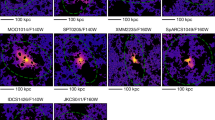Abstract
THE small dispersion in the absolute magnitude of the brightest member of rich clusters of galaxies has been interpreted by Peebles1 in terms of a statistical model based on a luminosity function common to all clusters. In this model it is assumed that the probability that there is a galaxy in a given cluster with absolute magnitude in the range M to M + dM is  is a universal function for all rich clusters. This form of ψ(M) is consistent with the bright end of the cumulative luminosity function for the Coma cluster determined by Abell2 with α = 1.8; M0, which can be derived from the observed mean luminosity of the brightest cluster members, is interpreted as a measure of the total number of galaxies in the cluster and thus of the cluster mass. On these assumptions Peebles shows that the probability distribution of the absolute magnitude M1 of the brightest member is
is a universal function for all rich clusters. This form of ψ(M) is consistent with the bright end of the cumulative luminosity function for the Coma cluster determined by Abell2 with α = 1.8; M0, which can be derived from the observed mean luminosity of the brightest cluster members, is interpreted as a measure of the total number of galaxies in the cluster and thus of the cluster mass. On these assumptions Peebles shows that the probability distribution of the absolute magnitude M1 of the brightest member is  Peebles has compared the distribution (3) with absolute magnitudes derived from the photographic photometry of eighteen brightest cluster galaxies by Humason, Mayall and Sandage3 ; he has also investigated the distribution of differences in absolute magnitude between the first brightest and the third, fifth and tenth brightest members. He concludes that the observations are compatible with the predictions of the model. Consequently, the brightest galaxies in clusters obey a statistical luminosity function smoothly extrapolated from the fainter members and there is nothing physically remarkable about their small luminosity dispersion.
Peebles has compared the distribution (3) with absolute magnitudes derived from the photographic photometry of eighteen brightest cluster galaxies by Humason, Mayall and Sandage3 ; he has also investigated the distribution of differences in absolute magnitude between the first brightest and the third, fifth and tenth brightest members. He concludes that the observations are compatible with the predictions of the model. Consequently, the brightest galaxies in clusters obey a statistical luminosity function smoothly extrapolated from the fainter members and there is nothing physically remarkable about their small luminosity dispersion.
This is a preview of subscription content, access via your institution
Access options
Subscribe to this journal
Receive 51 print issues and online access
$199.00 per year
only $3.90 per issue
Buy this article
- Purchase on Springer Link
- Instant access to full article PDF
Prices may be subject to local taxes which are calculated during checkout
Similar content being viewed by others
References
Peebles, P. J. E., Astrophys. J., 153, 13 (1968).
Abell, G. O., in Problems of Extra-Galactic Research (edit. by McVittie, G. C.), 213 (Macmillan, New York, 1962).
Humason, M. L., Mayall, N. U., and Sandage, A. R., Astron. J., 61, 97 (1956).
Oke, J. B., and Sandage, A. R., Astrophys. J., 154, 21 (1968).
Mattig, W., Astron. Nachrichten, 284, 109 (1958).
Abell, G. O., Astrophys. J. Suppl. Ser., 3, 211 (1958).
Morgan, W. W., Pub. Astro. Soc. Pacif., 70, 364 (1958).
Matthews, T. A., Morgan, W. W., and Schmidt, M., Astrophys. J., 140, 35 (1964).
Morgan, W. W., and Lesh, J. R., Astrophys. J., 142, 1364 (1965).
Zwicky, F., Morphological Astronomy, 171 (Springer-Verlag, Berlin, 1957).
Sastry, G. N., Pub. Astro. Soc. Pacif., 80, 252 (1968).
Author information
Authors and Affiliations
Rights and permissions
About this article
Cite this article
PEACH, J. Brightest Members of Clusters of Galaxies. Nature 223, 1140–1142 (1969). https://doi.org/10.1038/2231140a0
Received:
Issue Date:
DOI: https://doi.org/10.1038/2231140a0
This article is cited by
-
cD galaxies of apparent supergiant sizes due to the curvature of space
Astrophysics and Space Science (1986)
-
Brightest members of clusters of galaxies
Nature (1979)
-
Possible selection effects and their consequences on the determination of the model of the Universe from the redshift-magnitude relation of the brightest cluster galaxies
Astrophysics and Space Science (1971)
-
Brightest Members of Clusters of Galaxies
Nature (1970)
-
Bright End of the Galaxy Luminosity Function in Clusters
Nature (1969)
Comments
By submitting a comment you agree to abide by our Terms and Community Guidelines. If you find something abusive or that does not comply with our terms or guidelines please flag it as inappropriate.



